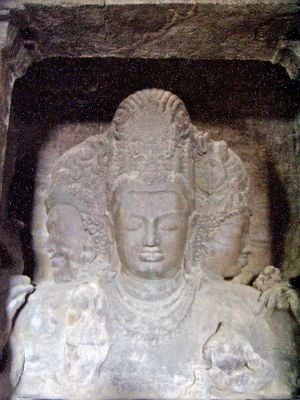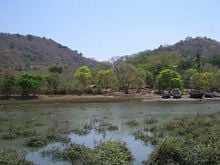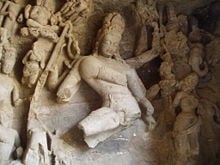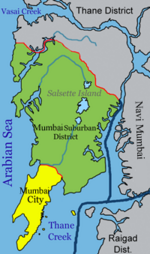Difference between revisions of "Elephanta Caves" - New World Encyclopedia
Dan Davies (talk | contribs) (article imported) |
Dan Davies (talk | contribs) |
||
| Line 1: | Line 1: | ||
| − | {{claimed}} | + | {{images OK}}{{started}}{{claimed}} |
| − | [[Image:Elephanta Mahesamurti 1.JPG|thumb|The Trimurti-Sadasiva Statue]]The '''Elephanta Caves''' | + | [[Image:Elephanta Mahesamurti 1.JPG|thumb|The Trimurti-Sadasiva Statue]]The '''Elephanta Caves''' represent the focal point of the [[Elephanta Island]], located in the [[Mumbai harbour]] off the coast of [[Mumbai]] (Bombay), [[India]]. In 1987, [[UNESCO]] designated the caves a [[UNESCO]] [[World Heritage Site]].<ref>{{cite web |
|url=http://whc.unesco.org/pg.cfm?cid=31&id_site=244 | |url=http://whc.unesco.org/pg.cfm?cid=31&id_site=244 | ||
|title=Elephanta Caves | |title=Elephanta Caves | ||
| Line 7: | Line 7: | ||
}}</ref> | }}</ref> | ||
| − | + | many domestic and foreign tourists have visited it. In recent years, complaints have been made that visitors mistreat this important cultural and historic site.<ref>{{cite web | |
|url=http://www.the-south-asian.com/Aug2004/Elephanta_caves.htm | |url=http://www.the-south-asian.com/Aug2004/Elephanta_caves.htm | ||
|title=Save the Caves | |title=Save the Caves | ||
| Line 17: | Line 17: | ||
|publisher=Bolography | |publisher=Bolography | ||
|accessdate=2006-10-14 | |accessdate=2006-10-14 | ||
| − | }}</ref> Most of the sculptures | + | }}</ref> Most of the sculptures had been defaced by the [[Portugal|Portuguese]], who used the sculptures as target practice in the 17th century. The Portuguese also gave the island its modern name,''[[Elephanta Island|Elephanta]]'' from ''Gharapuri''.<ref>HT Cafe, Mumbai, Monday, June,4,2007 p. 31 - Article 'Lord of the Islands" by Jerry Pinto</ref> |
| − | The caves | + | The caves have been dated back to the [[Silhara dynasty|Silhara]] kings of the [[9th century|9th]] through [[13th century|13th centuries]] (810–1260). <!--{{Fact|date=February 2007}}—> Some of the sculptures of the site have been attributed to the imperial [[Rashtrakutas]] of [[Manyakheta]] (in present day [[Karnataka]]), the ''Trimurti'' of Elephanta showing the three faces of Shiva almost akin to the [[Trimurti|Trinity]] of [[Brahma]], [[Vishnu]], and [[Mahesh]], the royal insignia of the Rashtrakutas. Other Rashtrakuta sculptures include the reliefs of [[Nataraja]] and [[Sadashiva]] and the splendid sculptures of [[Ardhanarishvara]].<!--{{Fact|date=June 2007}}—> |
| − | The rock-cut temple complex | + | The rock-cut temple complex covers an area of 60,000 sq ft consisting of a main chamber, two lateral ones, courtyards and subsidiary shrines. The site of those magnificent caves containes beautiful reliefs, [[sculpture]]s, and a [[temple]] to the [[Hindu]] [[god]] [[Śiva]]. The caves have been hewn from solid rock.<ref>{{cite web |
|url=http://www.mumbainet.com/travel/elephanta.htm | |url=http://www.mumbainet.com/travel/elephanta.htm | ||
|title=Elephanta Caves | |title=Elephanta Caves | ||
| Line 27: | Line 27: | ||
|accessdate=2006-10-14 | |accessdate=2006-10-14 | ||
}}</ref> | }}</ref> | ||
| − | + | Legend advances that the temple complex serves as the abode of [[Shiva]]. | |
| − | ==Trimurti-Sadashiva Statue== | + | === Trimurti-Sadashiva Statue === |
| − | + | Trimurti Sadasiva, carved in relief at the end of the North-South axis, embodies the most important sculpture. The three headed-Shiva image, representing Panchamukha Shivaimage, stands twenty feet high.<ref>Duffer's Guide to Elephanta, Mid-Day, Tinaz Nooshan, Feb 22, 2007, p. A14</ref> The right half-face shows him as a young person with sensuous lips, embodying life and its vitality. In his hand he holds something that resembles a rose bud; again with the promise of life and creativity. That face closely resembles [[Brahma]], the creator or [[Parvati|Uma]] or [[Vamadeva]], the feminine side of Shiva.<ref>HT Cafe, Mumbai, Monday, June 4, 2007 p. 31: Article 'Lord of the Islands" by Jerry Pinto</ref> The left half-face, on the side, resembles a young man, mustached, and angry. He depicts Shiva as [[Aghora]] [[Bhairava]]<ref>HT Cafe, Mumbai, Monday, June,4,2007 p. 31 - Article 'Lord of the Islands" by Jerry Pinto</ref>, as the one whose anger can engulf the entire world in flames leaving only ashes behind. That represents Shiva, the Destroyer. The central face, benign, meditative, as the preserver [[Vishnu]], depicting Shiva as the yogi—Yogeshwar—in deep meditation praying for the 'preservation' of humanity. | |
| − | + | ==Elephanta Island== | |
[[Image:India-Elephanta-Trees.jpg|thumb|220px|The island as seen from close to the boat landing.]] | [[Image:India-Elephanta-Trees.jpg|thumb|220px|The island as seen from close to the boat landing.]] | ||
[[Image:ElephantaRW1.JPG|thumb|220px|Sculpture inside a cave.]] | [[Image:ElephantaRW1.JPG|thumb|220px|Sculpture inside a cave.]] | ||
| − | '''Elephanta Island''' (also called '''Gharapuri Island''' or ''place of caves'') | + | '''Elephanta Island''' (also called '''Gharapuri Island''' or ''place of caves'') numbers among the islands in [[Mumbai Harbour]], east of [[Mumbai]], [[India]]. That island serves as a popular tourist destination for a day trip because of the island's [[cave]] [[temple]]s, the [[Elephanta Caves]], that have been carved out of rock. |
| + | |||
| + | The island, easily accessible by ferry from Mumbai, sits about 10 km from the south east coast of the island city. Boats leave daily from the [[Gateway of India]], taking about an hour each way for the journey. From the boat landing stage on the island, a walkway leads to steps that go up to the famous caves. Along the path, hawkers sell souvenirs that may bought at a reasonable price, as well as stalls to buy food and drinks. | ||
| + | |||
| + | Known in ancient times as '''Gharapuri''', [[17th century]] [[Portugal|Portuguese]] explorers, gave the present name '''Elephanta''', after seeing a monolithic basalt sculpture of an elephant found here near the entrance. They decided to take it home but ended up dropping it into the sea because their chains proved too weak. Later, the [[United Kingdom|British]] moved the sculpture to the [[Victoria and Albert Museum (Mumbai)|Victoria and Albert Museum]] (now [[Dr Bhau Daji lad Museum]]) in [[Mumbai]].<ref>HT Cafe, Mumbai, Monday, June,4,2007 p. 31 - Article 'Lord of the Islands" by Jerry Pinto</ref> | ||
| + | |||
| + | The island has an area of 16 km² (6 sq miles). It is located at approximately {{coor d|18.95|N|72.93|E|}}. The area comes under the jurisdiction of the [[Raigad]] district in [[Maharashtra]] State. A narrow gauge train takes tourists along the 1 km pier to the base of the steps which lead to the caves. The island, thickly wooded with palm, mango and tamarind trees, has a population of about 1,200 involved in growing rice, fishing, and repairing boats. The island once as the capital of a powerful local kingdom. | ||
| − | + | {{Islands of Mumbai harbour}} | |
| − | + | <!--{{credits|Elephanta_Island|173904928}} —> | |
| + | ==Mumbai Harbour== | ||
| − | The | + | [[Image:Bombayharbour.jpg|thumb|600px|center|A view of the harbour. The centre of the image is north-west.]] |
| + | [[Image:Mumbaicitydistricts.png|thumb|150px|The harbour east of the city]] | ||
| + | '''Mumbai Harbour''' (aka [[Front Bay]]) is the southern portion of the [[Ulhas River]] [[estuary]], the northern (and narrower) part of which is called [[Thane Creek]]. The historical island of [[Elephanta]] is one of the six islands that lie in the harbour. [[JNPT|Jawaharlal Nehru Port]] and [[Navi Mumbai]] (New Bombay) lie to the east on the mainland, and the city of [[Mumbai]] (formerly Bombay) lies to the west on [[Salsette]] Island. The harbour opens to the [[Arabian Sea]] to the south. The [[Gateway of India]] with its jetty for Elephanta is the most important tourist destination, followed by the [[INS Vikrant|INS ''Vikrant'']] maritime Museum. [[Mangrove]] swamps line much of the northwestern and eastern shores of the harbour, and provide a rich habitat for wildlife, including thousands of migrating birds such as [[flamingoes]]. | ||
| − | + | It has been the gateway since the days the [[United Kingdom|British]] established their factory in [[Mumbai]]. Over the years it is one of the important reasons for the development of trade and commerce in Mumbai. It is a [[natural harbour]] with three enclosed wet dock. They are named as | |
| + | * Indira Docks | ||
| + | * Prince's Docks (built in the year 1885) | ||
| + | * Victoria Docks (built in the year 1891) | ||
| + | [[Crude_oil|Crude]] and [[petroleum]] products are handled from four jetties at Jawahar Dweep an island in the mumbai harbour and chemicals are handled from Pirpau. It can be noted that the port has existed for over 130 years. | ||
| − | The | + | The Mumbai Port is managed by the Bombay Port Trust now known as Mumbai Port Trust which was founded by the great ship builder [[Jamshedji Wadia]] in 1872. |
| − | == | + | ==See also== |
| − | + | * [[Ports in India]] | |
| + | * [[Kolkata Port Trust|Kolkata Port]] | ||
| − | |||
| − | |||
| − | |||
| − | |||
| − | |||
| − | |||
| − | |||
{{Islands of Mumbai harbour}} | {{Islands of Mumbai harbour}} | ||
| − | <!--{{ | + | <!--{{Maharashtra-geo-stub}}—> |
| + | <!--{{water-stub}}—> | ||
| + | <!--{{credits|Mumbai_Harbour|175682810}} —> | ||
--------- | --------- | ||
| − | |||
| Line 80: | Line 88: | ||
==Reference notes== | ==Reference notes== | ||
{{commonscat|Elephanta}} | {{commonscat|Elephanta}} | ||
| + | <!--{{commonscat|Elephanta}}—> | ||
<references/> | <references/> | ||
| Line 91: | Line 100: | ||
*[http://www.boloji.com/photoessays/dv/monuments/dv003e.htm Elephanta Cave temple plan] | *[http://www.boloji.com/photoessays/dv/monuments/dv003e.htm Elephanta Cave temple plan] | ||
*[http://www.art-and-archaeology.com/india/elephanta/eleplan1.jpg North enterance temple plan] | *[http://www.art-and-archaeology.com/india/elephanta/eleplan1.jpg North enterance temple plan] | ||
| − | + | ||
* Archaeological Institute of America [http://www.archaeology.org/online/features/mandapeshwar/ Mumbai's Rough-Hewn Legacy] ''Archaeology'', February 12, 2007. | * Archaeological Institute of America [http://www.archaeology.org/online/features/mandapeshwar/ Mumbai's Rough-Hewn Legacy] ''Archaeology'', February 12, 2007. | ||
*[http://goldenboy.blog.com/2191551/ God’s Night Out: A blogger's article written after a visit to Elephanta Caves] | *[http://goldenboy.blog.com/2191551/ God’s Night Out: A blogger's article written after a visit to Elephanta Caves] | ||
| + | |||
| + | ==References== | ||
| + | |||
| + | * [http://www.mumbainet.com/travel/elephanta.htm Elephanta] | ||
| + | * [http://theory.tifr.res.in/bombay/architecture/building/elephanta.html Elephanta caves] | ||
| + | * Duffer's Guide to Elephanta, ''[[Mid-Day]]'', Feb 22, 2007, pg A14 | ||
| + | * [http://goldenboy.blog.com/2191551/ A blogger's description of the Island after having visited the Elephanta Caves] | ||
| + | {{Reflist}} | ||
{{Caves around Mumbai}} | {{Caves around Mumbai}} | ||
| Line 99: | Line 116: | ||
{{World Heritage Sites in India}} | {{World Heritage Sites in India}} | ||
| − | {{credits|174434630}} | + | {{credits|Elephanta_Caves|174434630|Elephanta_Island|173904928|Mumbai_Harbour|175682810|}} |
Revision as of 16:49, 14 December 2007
The Elephanta Caves represent the focal point of the Elephanta Island, located in the Mumbai harbour off the coast of Mumbai (Bombay), India. In 1987, UNESCO designated the caves a UNESCO World Heritage Site.[1]
many domestic and foreign tourists have visited it. In recent years, complaints have been made that visitors mistreat this important cultural and historic site.[2][3] Most of the sculptures had been defaced by the Portuguese, who used the sculptures as target practice in the 17th century. The Portuguese also gave the island its modern name,Elephanta from Gharapuri.[4]
The caves have been dated back to the Silhara kings of the 9th through 13th centuries (810–1260). Some of the sculptures of the site have been attributed to the imperial Rashtrakutas of Manyakheta (in present day Karnataka), the Trimurti of Elephanta showing the three faces of Shiva almost akin to the Trinity of Brahma, Vishnu, and Mahesh, the royal insignia of the Rashtrakutas. Other Rashtrakuta sculptures include the reliefs of Nataraja and Sadashiva and the splendid sculptures of Ardhanarishvara.
The rock-cut temple complex covers an area of 60,000 sq ft consisting of a main chamber, two lateral ones, courtyards and subsidiary shrines. The site of those magnificent caves containes beautiful reliefs, sculptures, and a temple to the Hindu god Śiva. The caves have been hewn from solid rock.[5] Legend advances that the temple complex serves as the abode of Shiva.
Trimurti-Sadashiva Statue
Trimurti Sadasiva, carved in relief at the end of the North-South axis, embodies the most important sculpture. The three headed-Shiva image, representing Panchamukha Shivaimage, stands twenty feet high.[6] The right half-face shows him as a young person with sensuous lips, embodying life and its vitality. In his hand he holds something that resembles a rose bud; again with the promise of life and creativity. That face closely resembles Brahma, the creator or Uma or Vamadeva, the feminine side of Shiva.[7] The left half-face, on the side, resembles a young man, mustached, and angry. He depicts Shiva as Aghora Bhairava[8], as the one whose anger can engulf the entire world in flames leaving only ashes behind. That represents Shiva, the Destroyer. The central face, benign, meditative, as the preserver Vishnu, depicting Shiva as the yogi—Yogeshwar—in deep meditation praying for the 'preservation' of humanity.
Elephanta Island
Elephanta Island (also called Gharapuri Island or place of caves) numbers among the islands in Mumbai Harbour, east of Mumbai, India. That island serves as a popular tourist destination for a day trip because of the island's cave temples, the Elephanta Caves, that have been carved out of rock.
The island, easily accessible by ferry from Mumbai, sits about 10 km from the south east coast of the island city. Boats leave daily from the Gateway of India, taking about an hour each way for the journey. From the boat landing stage on the island, a walkway leads to steps that go up to the famous caves. Along the path, hawkers sell souvenirs that may bought at a reasonable price, as well as stalls to buy food and drinks.
Known in ancient times as Gharapuri, 17th century Portuguese explorers, gave the present name Elephanta, after seeing a monolithic basalt sculpture of an elephant found here near the entrance. They decided to take it home but ended up dropping it into the sea because their chains proved too weak. Later, the British moved the sculpture to the Victoria and Albert Museum (now Dr Bhau Daji lad Museum) in Mumbai.[9]
The island has an area of 16 km² (6 sq miles). It is located at approximately . The area comes under the jurisdiction of the Raigad district in Maharashtra State. A narrow gauge train takes tourists along the 1 km pier to the base of the steps which lead to the caves. The island, thickly wooded with palm, mango and tamarind trees, has a population of about 1,200 involved in growing rice, fishing, and repairing boats. The island once as the capital of a powerful local kingdom.
| |||||
Mumbai Harbour
Mumbai Harbour (aka Front Bay) is the southern portion of the Ulhas River estuary, the northern (and narrower) part of which is called Thane Creek. The historical island of Elephanta is one of the six islands that lie in the harbour. Jawaharlal Nehru Port and Navi Mumbai (New Bombay) lie to the east on the mainland, and the city of Mumbai (formerly Bombay) lies to the west on Salsette Island. The harbour opens to the Arabian Sea to the south. The Gateway of India with its jetty for Elephanta is the most important tourist destination, followed by the INS Vikrant maritime Museum. Mangrove swamps line much of the northwestern and eastern shores of the harbour, and provide a rich habitat for wildlife, including thousands of migrating birds such as flamingoes.
It has been the gateway since the days the British established their factory in Mumbai. Over the years it is one of the important reasons for the development of trade and commerce in Mumbai. It is a natural harbour with three enclosed wet dock. They are named as
- Indira Docks
- Prince's Docks (built in the year 1885)
- Victoria Docks (built in the year 1891)
Crude and petroleum products are handled from four jetties at Jawahar Dweep an island in the mumbai harbour and chemicals are handled from Pirpau. It can be noted that the port has existed for over 130 years.
The Mumbai Port is managed by the Bombay Port Trust now known as Mumbai Port Trust which was founded by the great ship builder Jamshedji Wadia in 1872.
See also
- Ports in India
- Kolkata Port
| |||||
Gallery
Reference notes
- ↑ Elephanta Caves. World Heritage Site. Retrieved 2006-10-14.
- ↑ Save the Caves. south-asian.com. Retrieved 2006-10-14.
- ↑ Elephanta Caves. Bolography. Retrieved 2006-10-14.
- ↑ HT Cafe, Mumbai, Monday, June,4,2007 p. 31 - Article 'Lord of the Islands" by Jerry Pinto
- ↑ Elephanta Caves. Mumbai Net. Retrieved 2006-10-14.
- ↑ Duffer's Guide to Elephanta, Mid-Day, Tinaz Nooshan, Feb 22, 2007, p. A14
- ↑ HT Cafe, Mumbai, Monday, June 4, 2007 p. 31: Article 'Lord of the Islands" by Jerry Pinto
- ↑ HT Cafe, Mumbai, Monday, June,4,2007 p. 31 - Article 'Lord of the Islands" by Jerry Pinto
- ↑ HT Cafe, Mumbai, Monday, June,4,2007 p. 31 - Article 'Lord of the Islands" by Jerry Pinto
External links
- Video of the caves MTDC site
- Elephanta Caves Photos from Himanshu Sarpotdar
- - Photographs of elephanta and other sites in maharashtra
- Information on the caves
- Description of Rashtrakutas architecture in the caves
- TempleNet - Elephanta Caves
- Elephanta Cave temple plan
- North enterance temple plan
- Archaeological Institute of America Mumbai's Rough-Hewn Legacy Archaeology, February 12, 2007.
- God’s Night Out: A blogger's article written after a visit to Elephanta Caves
ReferencesISBN links support NWE through referral fees
- Elephanta
- Elephanta caves
- Duffer's Guide to Elephanta, Mid-Day, Feb 22, 2007, pg A14
- A blogger's description of the Island after having visited the Elephanta Caves
Template:Caves around Mumbai
| |||||||
Credits
New World Encyclopedia writers and editors rewrote and completed the Wikipedia article in accordance with New World Encyclopedia standards. This article abides by terms of the Creative Commons CC-by-sa 3.0 License (CC-by-sa), which may be used and disseminated with proper attribution. Credit is due under the terms of this license that can reference both the New World Encyclopedia contributors and the selfless volunteer contributors of the Wikimedia Foundation. To cite this article click here for a list of acceptable citing formats.The history of earlier contributions by wikipedians is accessible to researchers here:
The history of this article since it was imported to New World Encyclopedia:
Note: Some restrictions may apply to use of individual images which are separately licensed.












